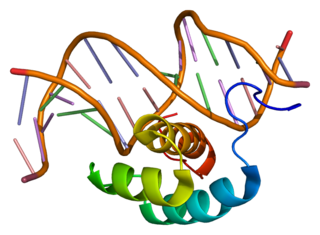
Homeobox protein Hox-B7 is a protein that in humans is encoded by the HOXB7 gene.

Homeobox D10, also known as HOXD10, is a protein which in humans is encoded by the HOXD10 gene.

Homeobox protein Hox-B5 is a protein that in humans is encoded by the HOXB5 gene.

Homeobox protein Hox-B1 is a protein that in humans is encoded by the HOXB1 gene.

Homeobox protein Hox-D3 is a protein that in humans is encoded by the HOXD3 gene.

Homeobox protein Hox-B3 is a protein that in humans is encoded by the HOXB3 gene.

Homeobox protein Hox-D9 is a protein that in humans is encoded by the HOXD9 gene.

Homeobox protein Hox-D4 is a protein that in humans is encoded by the HOXD4 gene.

Paired related homeobox 1 is a protein that in humans is encoded by the PRRX1 gene.

Homeobox protein Hox-D12 is a protein that in humans is encoded by the HOXD12 gene.

Homeobox protein engrailed-1 is a protein that in humans is encoded by the EN1 gene.

Homeobox protein Hox-D1 is a protein that in humans is encoded by the HOXD1 gene.

Homeobox protein Hox-C5 is a protein that in humans is encoded by the HOXC5 gene.

Homeobox protein Hox-D8 is a protein that in humans is encoded by the HOXD8 gene.

Homeobox protein Nkx-6.2 is a protein that in humans is encoded by the NKX6-2 gene.

Homeobox protein DBX1, also known as developing brain homeobox protein 1, is a protein that in humans is encoded by the DBX1 gene. The DBX1 gene is a transcription factor gene that is pivotal in interneuron differentiation in the ventral spinal cord. The spinal interneurons V0 and V1 are derived from progenitor domains that are differentiated by the expression of homeodomain proteins DBX1 and DBX2. DBX1 is spatially restricted and has a critical role in establishing the distinction of V0 and V1 neuronal fate. In DBX1 mutant mice, neural progenitors fail to generate V0 interneurons and instead gave rise to interneurons expressing V1 characteristics, such as their transcription factor profile, neurotransmitter phenotype, migratory pattern, and aspects of their axonal trajectory, suggesting that this single homeodomain transcription factor coordinates many of the differentiated properties of one class of interneurons generated in the ventral spinal cord. V0 and V1 interneurons are thought to be critical in the role of rhythmic breathing, after using a neonatal mouse model. Destruction of these DBX1 neurons in the pre-Botzinger complex showed an impaired respiratory rhythm as well as a decreased magnitude of motor output activity.

Homeobox protein DBX2, also known as developing brain homeobox protein 2, is a protein that in humans is encoded by the DBX2 gene.

Homeobox protein Mohawk, also known as iroquois homeobox protein-like 1, is a protein that in humans is encoded by the MKX gene.

Short stature homeobox 2, also known as homeobox protein Og12X or paired-related homeobox protein SHOT, is a protein that in humans is encoded by the SHOX2 gene.
The public domain consists of all the creative works to which no exclusive intellectual property rights apply. Those rights may have expired, been forfeited, expressly waived, or may be inapplicable.

Pfam is a database of protein families that includes their annotations and multiple sequence alignments generated using hidden Markov models. The most recent version, Pfam 32.0, was released in September 2018 and contains 17,929 families.
InterPro is a database of protein families, domains and functional sites in which identifiable features found in known proteins can be applied to new protein sequences in order to functionally characterise them.














